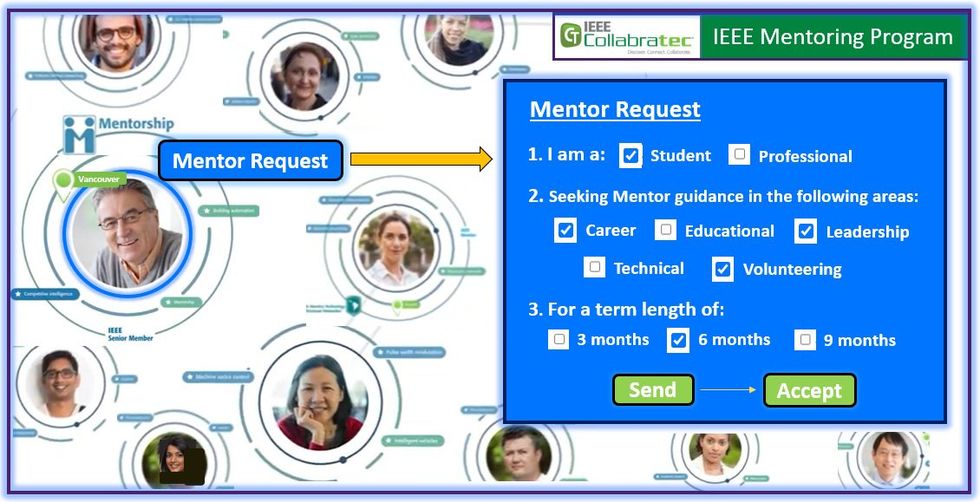Members, would you like to provide advice to a young professional? Or are you a student who will soon be entering the engineering workforce and would like to know more about a specific technical discipline from someone with experience? Consider participating in the IEEE Mentoring Program offered by IEEE Collabratec.
The online networking and collaboration program helps pair members who want to be mentors with those who are seeking guidance on topics such as their career, education, leadership, volunteering, or a particular technical field.
Participation in the program is open to IEEE members of any grade, including student members, as well as members of IEEE societies and the IEEE Standards Association.
The benefits of mentoring
Both mentor and mentee can gain valuable experience through the program, IEEE Member Craig Polk says in a video about the benefits of mentoring.
Potential benefits include improving technical and research abilities and enhancing communication and soft skills.
Polk is the technical community program manager for IEEE Future Networks, in Piscataway, N.J.
Mentees and mentors get to meet people from different companies, organizations, countries, and age groups, he adds.
Mentoring is something to look at from many ways: continual learning and growing, as well as continuous teaching, instruction, and impacting others.
Anyone can be a mentor, whether a seasoned professional, student, or colleague.
“Don’t discount the experiences of others,” Polk says. “There are things we can learn, but we also have knowledge and perspectives that we can impart to others.”
In the video, Polk says 37 percent of employees and 25 percent of college students have participated in a mentoring program. Of those who have mentored, 97 percent reported that it was a valuable experience, he says. Meanwhile, 89 percent of mentees go on to become a mentor. Eighty percent of CEOs said they received some form of mentoring during their career. Mentees are promoted five times more often than their colleagues without a mentor, and mentors themselves are six times more likely to get promoted, according to the reports.
Polk explains how the mentorship program works, explores the stages of mentoring relationships, and offers tips for success.

Steps for finding a mentor
First, review the IEEE Mentoring Program guidelines to learn about the shared responsibilities between the mentor and mentee, as well as best practices for setting and achieving goals for the relationship.
After logging in to your IEEE Collabratec account, go to your profile, which can be found under the settings page. Members’ profiles are automatically populated with information such as location, education, degree, IEEE society memberships, and current and past volunteer positions. From the Edit button at the top of the profile page, additional information can be added, such as technical interests, technical expertise, and specialties. Such information can prove essential to a mentor and mentee in the selection and acceptance process.
The next step is to make sure your profile is visible to others by using the Edit Privacy button to set it to IEEE member.
Once you’ve finished those steps, it’s time to activate your mentor or mentee status (you can be both). The Career Services button on the left console of either the dashboard or home page will bring you to a page where you can access all mentoring functionalities, such as activating your status, accepting a pending request, and tracking your partnership.
Mentors activate their status, then fill in their mentee preferences and wait for a request from a prospective mentee.
Mentees are presented with a list of all mentors. The list displays a quick-view pop-up profile summary of prospective people. The list can be further refined by searching by member grade, society, and technical interests. The quick-view summary includes the Mentor Request button as well as a Message button.
Before sending a mentor a request, mentees first should send a message to the person to discuss such things as their goals, fields of expertise, and availability to meet.
When mentees find someone who aligns with their mentoring goals, they should click the Mentor Request button. Doing so opens a simple form that asks whether the mentee is a student or working professional; areas of guidance being sought; the length of the relationship (3, 6, 9, or 12 months); and a free-form box to request additional information.
A mentoring partnership status console is displayed on the Career Services page, with the pending partnership listed as well as the pending request form available for review by the mentor. Once a mentor accepts a request, the partnership status changes from pending to active.
The system also automatically creates a workspace for the pair. They can share links, images, videos, and documents; upload files; and use the Project Tracker task-management tool.
More than 1,300 mentoring partnerships have been formed.
Mentoring resources such as videos are available by joining the IEEE Mentoring Program and Career Forum.
As Polk says in the video, mentoring is something to look at “from many ways: continual learning and growing, as well as continuous teaching, instruction, and impacting others.”
This article appears in the September 2023 print issue as “Elevate Your Career With the IEEE Mentoring Program.”
- A New One-Stop Resource for IEEE Life Members ›
- This New IEEE Volunteering Platform Lists Opportunities Around the World in One Place ›
- Connect with Engineers Worldwide Through the IEEE App ›
- Games for Those Who Love to Solve Brainteasers ›
- Advance Your Skills in Wireless Communication Technologies - IEEE Spectrum ›
- Volunteer Training Program Sees Record Growth As it Marks 10 Years - IEEE Spectrum ›
- IEEE Introduces Digital Certificates Documenting Volunteer Roles - IEEE Spectrum ›
- IEEE Collabratec Reaches 100,000 Member Milestone - IEEE Spectrum ›
Kathy Pretz is editor in chief for The Institute, which covers all aspects of IEEE, its members, and the technology they're involved in. She has a bachelor's degree in applied communication from Rider University, in Lawrenceville, N.J., and holds a master's degree in corporate and public communication from Monmouth University, in West Long Branch, N.J.


